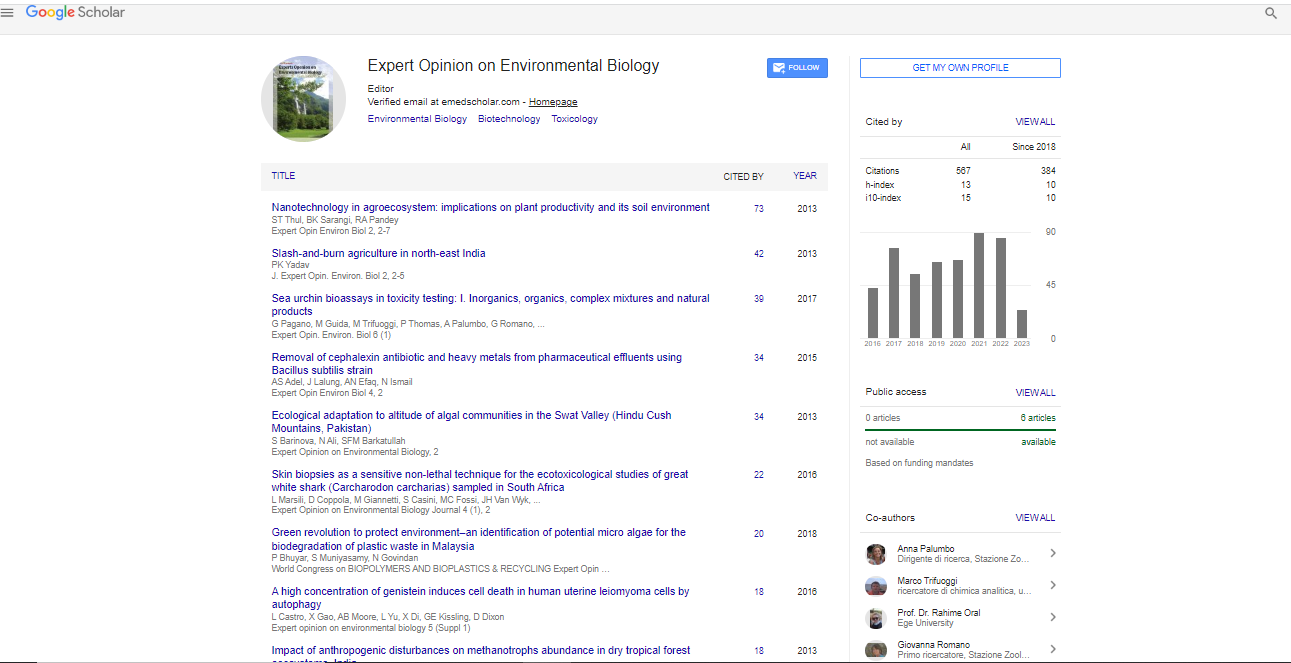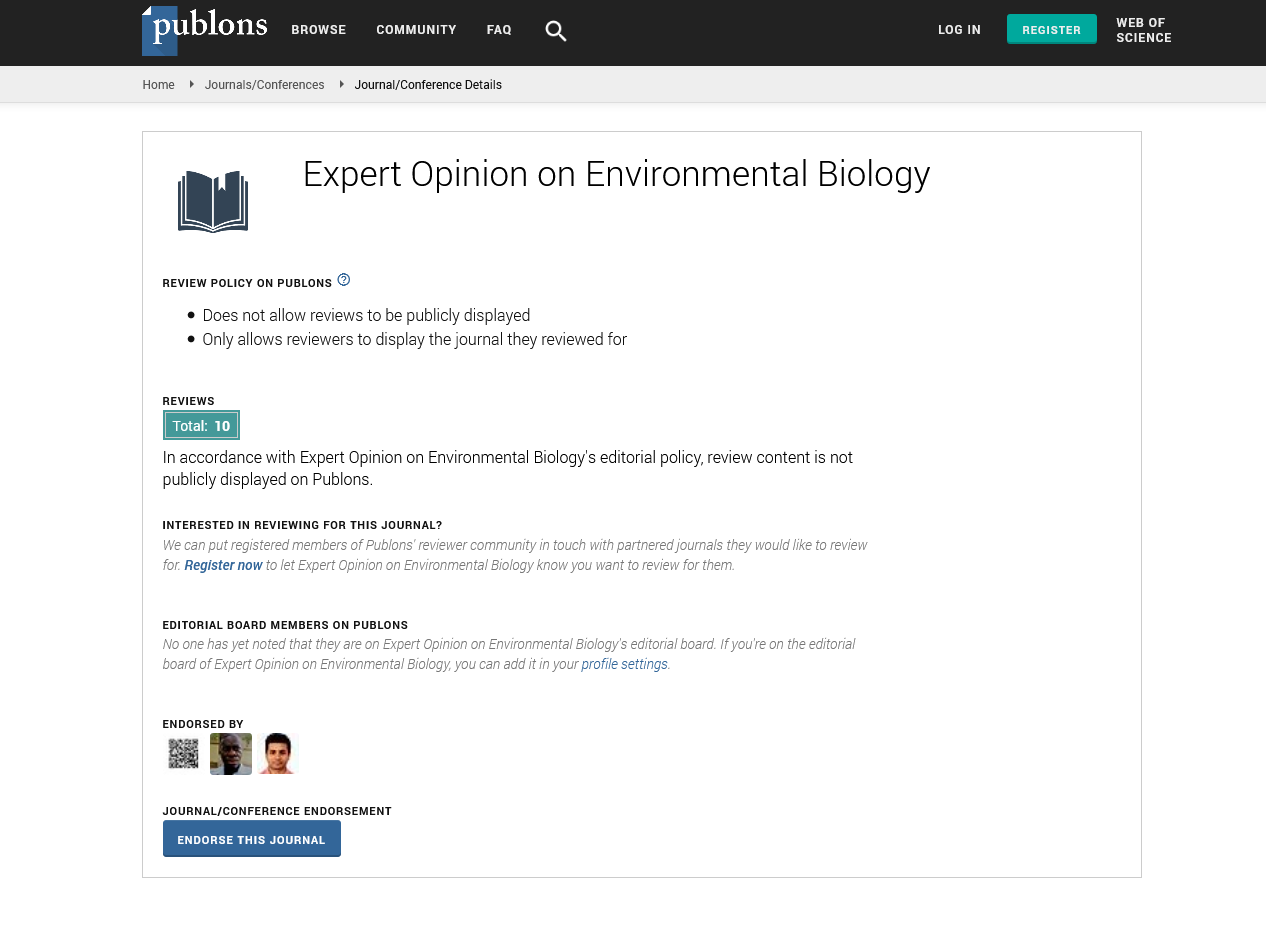Short Communication, Expert Opin Environ Biol Vol: 14 Issue: 1
The Role of Environmental Microbiology in Ecosystem Health
Runnan Chettri*
Department of Environment and Ecology, Environmental Research University, India
- *Corresponding Author:
- Runnan Chettri
Department of Environment and Ecology, Environmental Research University, India
E-mail: runnan_chettri@tu11.in
Received: 01-Mar-2025, Manuscript No. EOEB-25-169981, Editor assigned: 03-Mar-2025, PreQC No. EOEB-25-169981(PQ), Reviewed: 17-Mar-2025, QC No. EOEB-25-169981, Revised: 21-Mar-2025, Manuscript No. EOEB-25-169981(R), Published: 28-Mar-2025, DOI: 10.4172/ 2325-9655.1000242
Citation: Runnan C (2025) Advancing Cardiac Healing: The Role of Stem Cells in Regeneration and Future Prospects. J Regen Med 14:1.
Copyright: © 2025 Runnan C. This is an open-access article distributed under the terms of the Creative Commons Attribution License, which permits unrestricted use, distribution and reproduction in any medium, provided the original author and source are credited.
Abstract
Environmental microbiology plays a pivotal role in sustaining
ecosystem health by regulating nutrient cycles, decomposing
organic matter, and mitigating pollutants. Microorganisms, including
bacteria, fungi, archaea, and viruses, influence soil fertility, water
quality, and atmospheric composition. Their interactions contribute
to ecosystem resilience against environmental stresses. Recent
advancements in molecular tools, such as metagenomics, have
enabled the identification of previously unknown microbial species
and functions, deepening our understanding of microbial diversity.
This article examines the essential functions of environmental
microorganisms, their role in biogeochemical processes, and
their potential in bioremediation and climate change mitigation.
It also explores challenges in preserving microbial diversity amid
anthropogenic pressures like pollution and habitat destruction,
proposing strategies for microbial conservation to maintain
ecosystem stability.
Keywords: Environmental microbiology; Nutrient cycling; Bioremediation; Microbial diversity; Ecosystem resilience
Keywords
Environmental microbiology; Nutrient cycling; Bioremediation; Microbial diversity; Ecosystem resilience
Introduction
Microorganisms are fundamental to life on Earth, driving processes that sustain ecosystems. Environmental microbiology focuses on the study of microorganisms in natural environments, examining their diversity, interactions, and functions. These microbes are involved in recycling nutrients, detoxifying pollutants, and maintaining soil and water health. Advances in molecular biology have revolutionized the study of environmental microbiology, revealing the vast diversity and complexity of microbial communities. This paper discusses the role of environmental microbiology in maintaining ecosystem health, with emphasis on nutrient cycling, bioremediation, and resilience to environmental change [1].
Description
Microorganisms are the unsung heroes of ecosystems, participating in processes essential for life. In soil, bacteria and fungi decompose organic matter, releasing nutrients that plants can absorb. Nitrogen-fixing bacteria convert atmospheric nitrogen into forms usable by plants, playing a key role in the nitrogen cycle. Similarly, microbes drive the carbon cycle by breaking down complex organic compounds and regulating greenhouse gas emissions. In aquatic ecosystems, microorganisms contribute to water purification by breaking down organic pollutants and maintaining oxygen balance. They also form symbiotic relationships with aquatic plants and animals, influencing biodiversity [2].
The emerging field of environmental genomics has shed light on previously uncultivable microorganisms, expanding our knowledge of their ecological roles. Metagenomic analyses have revealed genes involved in pollutant degradation, making microbes valuable tools in bioremediation. For instance, certain bacterial strains can degrade oil spills, while others can neutralize heavy metals in contaminated soils. However, human activities threaten microbial diversity. Pollution, land-use changes, and climate change disrupt microbial habitats, leading to reduced ecosystem functionality. Conservation strategies, including habitat protection, pollution control, and the restoration of degraded environments, are critical to preserving microbial diversity [3], [4].
Results
Studies have shown that diverse microbial communities enhance ecosystem resilience to disturbances, such as drought and pollution. Restoration projects that incorporate microbial inoculation have improved soil health and plant growth in degraded landscapes. Microbial-based bioremediation has successfully reduced contaminants in water and soil, demonstrating the potential for environmentally sustainable solutions. Molecular monitoring techniques, such as environmental DNA (eDNA) analysis, have enabled the tracking of microbial community changes over time, providing valuable data for conservation efforts [5].
Conclusion
Environmental microbiology is integral to ecosystem health, influencing nutrient cycling, pollutant degradation, and overall biodiversity. The protection of microbial diversity is essential for ecosystem stability and resilience. Advances in molecular techniques have opened new avenues for understanding microbial functions and harnessing their potential in environmental management. Sustainable practices that preserve and restore microbial communities will be crucial in addressing environmental challenges and maintaining the planetâ??s ecological balance.
References
- Debru A (2006) The power of torpedo fish as a pathological model to the understanding of nervous transmission in Antiquity. C R Biol 329: 298-302.
- Fisher R, van Emde Boas W, Blume W, Elger C, Genton P, et al. (2005) Epileptic seizures and epilepsy: definitions proposed by the International League Against Epilepsy (ILAE) and the International Bureau for Epilepsy (IBE). Epilepsia 46: 470-472.
- Friedman JH, Brown RG, Comella C, Garber CE, Krupp LB, et al. (2007) Fatigue in Parkinson's disease: a review. Mov Disord 22: 297-308.
- Friedman JH, Friedman H (2001) Fatigue in Parkinson's disease: a nine-year follow up. Mov Disord 16: 1120-1122.
- Friedman J, Friedman H (1993) Fatigue in Parkinson's disease. Neurology 43: 2016-2018.
 Spanish
Spanish  Chinese
Chinese  Russian
Russian  German
German  French
French  Japanese
Japanese  Portuguese
Portuguese  Hindi
Hindi 
